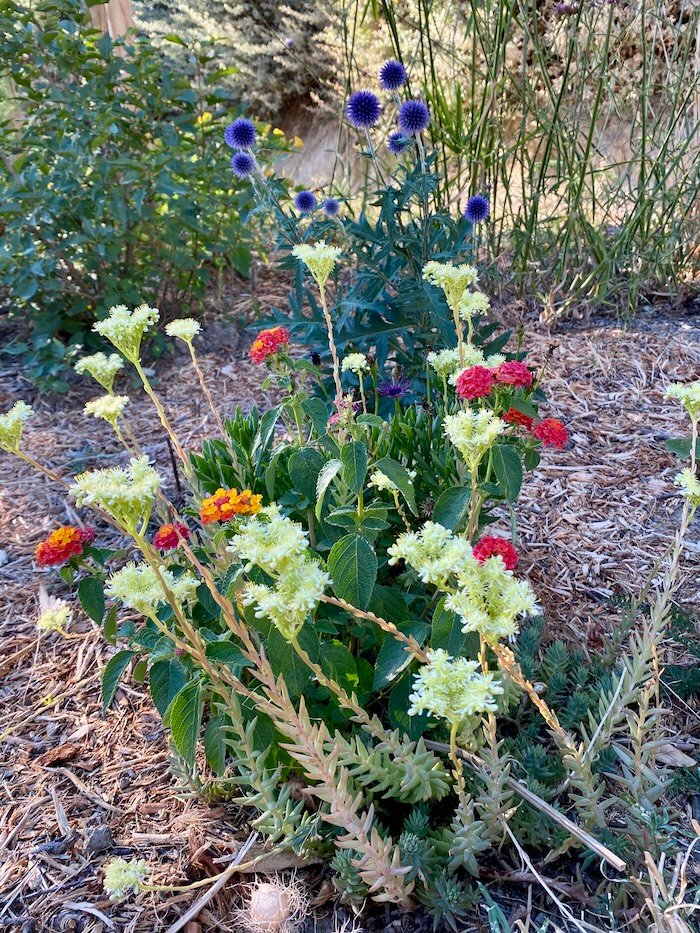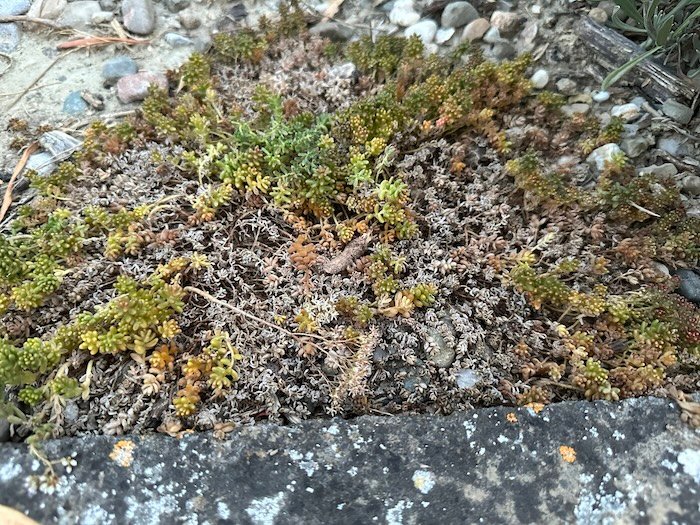Sedum and sempervivum are very drought and frost tolerant plants and are sold as such by garden centers. However, all will not work in our particular Mediterranean climate and I can only kick myself for omitting “due diligence” research before trusting garden center descriptions.
Petrosedum sediforme
This true mediterranean native grows all over this garden in plain earth as well as in the cracks of the dry stone walls. It also grows wild in the garrigue and in rocky meadows. It’s very easy to establish and propagate and very pretty when it blooms in the summer. The flowering stalks can reach a height of 50 cm. The plant is an evergreen perennial succulent and its bluish-green leaves are edible.
Since this type of sedum was doing so well I decided to try some others in a dry and sunny part of the garden. Only a few have survived and not all of those are really thriving either.



Sedum album murale and Coral Carpet
Very low-growing plants that need to be planted away from others since they cannot compete with bigger, more vigorous species. They are specially adapted for growing on thin dry soils and will grow on walls and among rocks. Most of the year they look like a low green mat, but when they flower in the summer, the stems grow erect and show tiny white flowers. Coral Carpet will turn red when it gets cold.
Sedum album grows from northwest Africa to southern Scandinavia and native to almost all European countries, growing up to altitudes of 2500 meters in Switzerland.


In our garden Sedum album Coral Carpet was doing well, spreading, blooming, and propagating – until this year’s unseasonal heatwave in June. After several weeks of 36-40 degrees without water, it is appearing to want to meet its maker. While, right next to it, the original Sedum album that grows “wild” all over the garden, is blooming and thriving. No more garden-center-bought sedums for this garden!


Sedum spurium variegatum and Album superbum
Creeping stems that are supposed to quickly cover the ground with variegated foliage and grow pretty pink flowers. So far mine only have a few pink and white leaves and no flowers. Probably because this plant is actually a native of rocky subalpine (1250-3000 meters) meadows in Southeastern Europe – so it’s too hot for it in this garden.
Sedum spathulifolium Cape Blanco
A native to western North America from Canada to California, where it grows mostly in the shade in hills and mountains. So again, the wrong plant for my hot Mediterranean garden where it has disappeared without a trace.
Sedum (Rhodiola) pachyclados
Another bad choice that disappeared without a trace, since it turns out to be a native to the Western Himalayas, growing between 2400 and 3400 meters…


Sedum Lemon Ball
This one I bought in the local garden center last October because it’s bright green color was and is so pretty. It has survived the winter without any problems and has bloomed in late spring.
Sedum (Hylotelephium) thelephium Thunderhead
Ever since I saw a dark Hylotelephium in another garden I wanted one too. I planted two very small “Thunderhead” in October of 2024 but they both disappeared quickly in winter. Sometime in May one of them showed up again and is now slooooowly growing.
Sempervivum “Chick Charms”
Sempervivum may grow on the roofs of houses but they don’t grow in my garden. I planted several in October 2023 and while they did very well in winter and spring, almost all of them have died over the past two summers. They are really natives of mountainous, subalpine and alpine regions and apparently even need protection from extrem sun exposure…


Leave a Reply